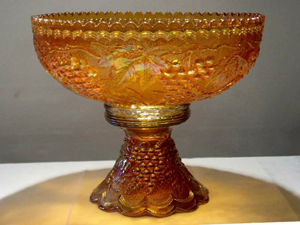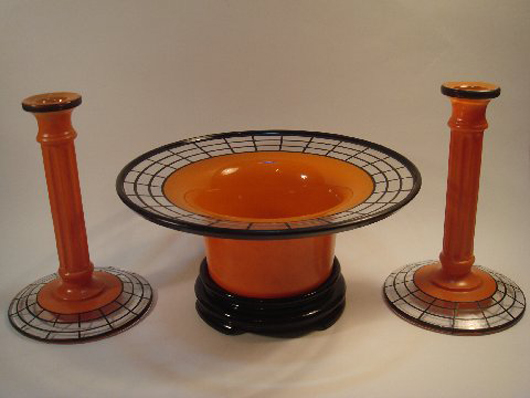
Creepy crawlers and things that go bump in the night are always welcome this time of year. Ghosts and goblins yelling, “Trick or treat,” carved pumpkins illuminated on the porch and your teenagers couch-bound for a night filled with popcorn and scary movies – Halloween is right around the corner.
Some of us who still enjoy a good Halloween bash like to decorate our homes for the speceal evening. You might invite a few friends over for a costume party complete with a dinner menu of brain spaghetti, ladies’ fingers and “ghoul”lash. But wait! What will you serve this tasty meal on? Why, Halloween glass, of course!
What do I mean by Halloween glass? Glass produced in shades of white, red, black and orange. The colors you might not think of serving food on. How appetizing would it really look? Fortunately, there was enough glass made in these colors during the early 1900s to the 1960s to fit any pocketbook. If you take the time to think about how many people who have passed on that used the glass described below, you might find the glassware to be “haunted.”
Black glass has been used since the 1700s to make wine bottles and other types of bottles. We find it being used again by several of the Depression and Elegant Depression glass manufacturers from the 1920s thru the 1940s. Black glass is semiopaque/opaque glass and is often confused with black amethyst and black ruby glass. One of the easier ways to determine which color it is would be to hold it up to strong light. If the glass changes to a deep red hue – it would be black ruby. If it shows a deep purple color, it is black amethyst.
Milk glass, often referred to as milk white or just white, is an opaque glass that looks like it is made of milk. The earliest known examples of opaque white glass was made in Egypt in 1500 B.C. Around the mid 1800s, milk glass became popular again and was produced by firms in France, America and England. Kitchen and dinnerware were mass-produced to meet the growing demand by consumers. Two of the most recognized American firms producing this glass were Imperial and Westmoreland. Opalescent glass, a crystal-based glassware with a ghostly appearance could be another example to use for white.
Red or royal ruby glass is translucent and blood red – fitting for the occasion. Several companies produced ruby glass. Royal Ruby was the name originally used by Anchor Hocking for their red line of glassware, however, most collectors use the term to describe the red color of most commercially produced glass of the period. Royal Ruby produced before 1950 contained some form of gold that gave the glass its deep red color. Ruby glass produced after 1950 the formula contained bismuth, tin and copper were used to create the red color. Eventually, bismuth was removed from the formula altogether.
Orange glass was not a color widely produced by glass manufacturers. The Akro Agate Co. made a small amount of orange colored glass produced from around 1925 to 1949. Akro Agate collectors coined the name “pumkpin.” Fire-King Peach Lustre, made by the Anchor Hocking Glass Co. from 1952 to 1963, is inexpensive and readily found. It offers a lighter, creamy shade of orange with a topcoat shine. Another product produced in the 1940-50s is Moderntone, made by the Hazel Atlas Co. It came in several fired-on colors, orange being one of them.
An alternative, though not always as cheap, would be Carnival glass. Carnival glass was mainly an American phenomenon, however, it was also produced in several other countries in comparatively small amounts. Marigold, an iridescent shade of orange, was the most common of the array of colors produced. Originally, the marigold color was called Golden Iris or Rubigold. For diehard Halloween enthusiasts, you could also pick from shades of white such as pearl, moonstone (similar to white but more opaque), or simply white. Also available were several shades of red such as amberina, red, red opalescent, reverse amberina, brick red and red slag. Black was made but in small quantities by Sowerby’s in the United Kingdom. The most fitting of all the shades of marigold is pumpkin. Carnival glass was produced from around 1907 to 1925.
As you can see, Halloween can be more than just passing out handfuls of candy to the trick or treaters Its about creepy glassware and the stories behind them.
Spooky Patterns
Perhaps you would like a Halloween theme to your dinnerware. Here are a few patterns that fit the bill of fare:
Carnival Glass:
Autumn Acorns – Not too scary but it has a Fall theme showing autumn leaves and acorns swirling about.
Boggy Bayou – Perfect marigold vase for black roses.
Dragon’s Tongue – Found mostly in light shades of milk glass with a marigold iridescence.
Halloween – Marigold water set that has a black rim and handle. A great way to dispense, blood punch?
Heavy Web – Found mostly in bowl shapes in peach opalescent.
You can also choose from a nice “Covered Urn” to place on the mantel.
Carnival glass producers also made what we call “funeral vases.” What were they thinking?
Imperial made a pair of rare candlesticks called “Crucifix.” True to form they are shaped like a cross. Rumor has it, they were last seen in Transylvania.
Depression and ’40s, ’50s and ’60s Patterns
Crow’s-foot – Paden City designed this pattern, most commonly sought-after in red.
Black Forest – Elegant glass made in several colors, including black and red.
Candlelight – Another elegant glass pattern produced in crystal but offer candlesticks to help illuminate your haunted house.
Saturn – Your alien guests might be delighted with this pattern of dinnerware.
One more thing to consider: glass knives. Originally made during the depression era as knives for cutting citrus fruits, tomatoes, cakes etc. They were advertised as being sanitary, and stain resistant. Keep this with you along side the holy water and garlic cloves.
Now you’ve decided it sounds like a great idea for your pending Halloween bash, where to find such Halloween glass?
Online:
Just Glass Mall – http://www.justglassmall.com
eBay – http://www.ebay.com
Happy Halloween!
Captions:
(for console bowl and candlestikes)
Spooky glass console set. Image courtesy of Gordon H. Hancock, Tiffany Pastel Art Glass Specialist, pasteltiffany@aol.com
(for Carnival glass punchbowl)
Carnival glass witches brew punch bowl. Image courtesy of Prentiques.com
ADDITIONAL IMAGES OF NOTE


